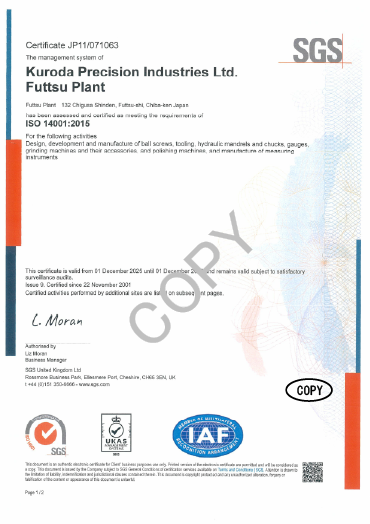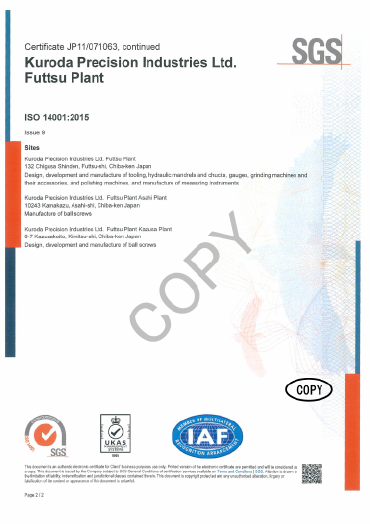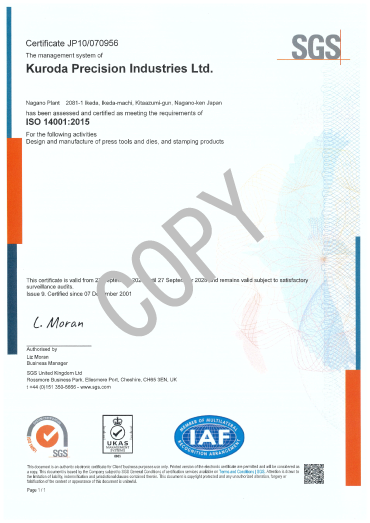Environmental Initiatives
 Environment
Environment
The KURODA group, consisting of KURODA Precision Industries Ltd. and its affiliated companies, as a responsible corporate citizen, works on environmental issues by placing environmental conservation as one of the most important issues in management. At the KURODA group, we aim at not only saving resources and energy and reduce waste in our corporate activities, but also reducing the environmental load of the products we provide to our customers.
Environmental Philosophy
Based on our P&P (Precision & Productivity) corporate philosophy, the KURODA group will actively and continuously work on environmental conservation as one of the most important issues in management, protecting the rich nature and taking care of the valuable resources through our corporate activities.
Basic Policy
- We do not only establish this Environmental Policy, but also continuously improve our management of the environment.
- To provide products with low environmental load, we will consider the impact on the environment of each process of our corporate activities, from product planning to design, manufacturing, distribution, sales, and use to disposal.
- In addition to abiding by laws and regulations and regional requirements regarding the environment, we will do our utmost to prevent environmental pollution and continuously lower environmental load as well as to conserve the environment effectively by developing necessary technologies.
- Recognize that we conduct business by using earth’s finite resources and actively work on “saving energy and resources,” “CO2 emission reduction,” and “reducing waste” to curve global warming and to pass on valuable natural resources to future generations.
- Spread the Environmental Policy and importance of the conservation of earth’s environment through environmental education to all personnel, in-house information activities, as well as promote activities about environmental conservation awareness.
- Set a purpose and objective to fulfil the Environmental Policy to act systematically, in addition to periodically reviewing the activities for continual improvement.
- Make this Environmental Policy available to the general public.
Kuroda Precision Industries Ltd.
President
Hiroshi Kuroda
Acquisition of ISO 14001 Certificate
Futtsu Plant
(Including Asahi Plant and Kazusa-Academia Plant)


Nagano Plant

Setting new targets for reducing CO2 emissions
Kuroda Precision Industries Co., Ltd. (Kawasaki City, Kanagawa Prefecture) set medium- to long-term targets for reducing CO2 emissions in December 2019 based on the government targets at the time. We have raised our Scope 1 + Scope 2 *1 reduction target for fiscal year 2030 from 29% reduction compared to fiscal year 2018 to 40%, and aim to achieve carbon neutrality by fiscal year 2050.
Background to the target review
In October 2020, former Prime Minister Suga declared carbon neutrality by 2050, and announced that the greenhouse gas reduction target for 2030 would be a 46% reduction compared to fiscal 2013 levels. As specific details, the "Global Warming Countermeasures Plan *2" was approved by the Cabinet on October 22, 2021, which clearly states the target of reducing energy-related CO2 emissions by 45% from fiscal 2013 levels by fiscal 2030, and sets out reductions by sector, including a 38% reduction in the industrial sector, a 51% reduction in the commercial and other sectors, a 66% reduction in the residential sector, and a 35% reduction in the transport sector.
Towards achieving the 2030 target
1. Energy conservation
In 2018 and 2019, four of our domestic factories *3 underwent energy-saving and power-saving diagnosis by the Energy Conservation Center, Japan. In December 2019, we announced that the potential for CO2 emissions reduction through capital investment and operational improvements was approximately 490 t-CO2. However, we plan to increase this to 520 t-CO2 through further capital investment, and will continue to implement these measures sequentially towards 2030.
2. Introduction of renewable energy
A solar power generation system based on the PPA model *4 was installed on the roof of the Kazusa Academia Factory in May 2020, and in the year since it began operation, it has generated 600,000 kWh of electricity, reducing CO2 emissions by 285 t-CO2.
We are considering installing the system at the Futtsu Factory and Nagano Factory in the future, and we expect to reduce CO2 emissions by 570 t-CO2 in total at the three factories.
-

Kazusa Academia Factory introduced the solar power generation system.
3. Reduction of grid power CO2 emission factor
In order to achieve the government's long-term energy supply and demand outlook, the electric power industry set a target of 0.37kg-CO2/kWh *5 for CO2 emissions by fiscal 2030 in July 2015. "6th Basic Energy Plan (October 2021)(Japanese)" Published in "Energy supply and demand outlook for fiscal 2030 (related materials)(Japanese)" Considering that the average CO2 emission coefficient for all power sources in fiscal 2030 calculated from this is 0.253 kg-CO2/kWh *6, we expect a reduction effect of 2,350 t-CO2.

Towards achieving carbon neutrality by 2050
We will continue our energy-saving measures beyond fiscal 2030. In addition, assuming that we are in an environment where we can purchase electricity at economically reasonable procurement prices, we will aim to achieve carbon neutrality through measures including switching to carbon-free electricity derived from renewable energy sources, electrifying our energy usage, and carbon offsetting for emissions that are difficult to reduce through afforestation (J-Credit Scheme), etc.
- Scope 1: Direct greenhouse gas emissions from fuel use within the company
Scope 2: Indirect greenhouse gas emissions from the use of electricity purchased by the company (emissions at power plants) - Materials on the Ministry of the Environment website(Japanese) See
- Futtsu Factory, Kazusa Academia Factory, Asahi Factory, Nagano Factory
- An abbreviation for "Power Purchase Agreement Model." A model in which a PPA operator installs a solar power generation system on the roof or other space of an electricity consumer, and the electricity generated there is purchased by the electricity consumer.
- Federation of Electric Power Companies website(Japanese) See
- Agency for Natural Resources and Energy "Energy supply and demand outlook for fiscal 2030 (related materials)(Japanese)" This is the value calculated as the average CO2 emission coefficient (end-use) for all power sources in FY2030 based on the "FY2030 electricity demand: 864 billion kWh" on page 70 and the "FY2030 electricity-derived CO2 emissions: 219 million t-CO2" on page 75.
